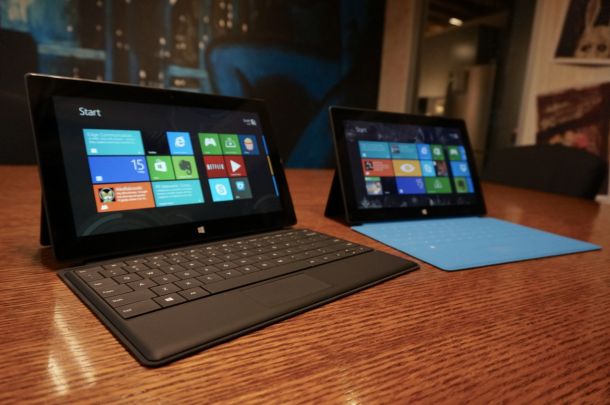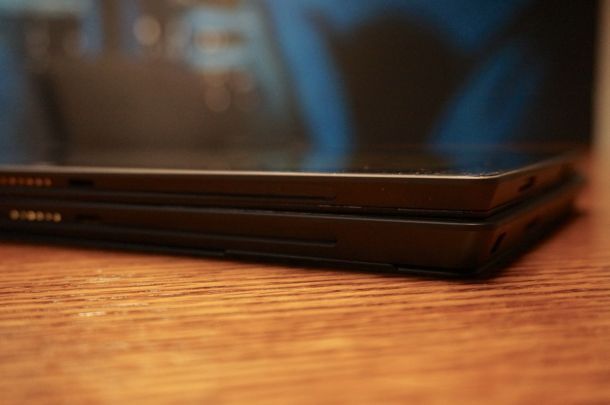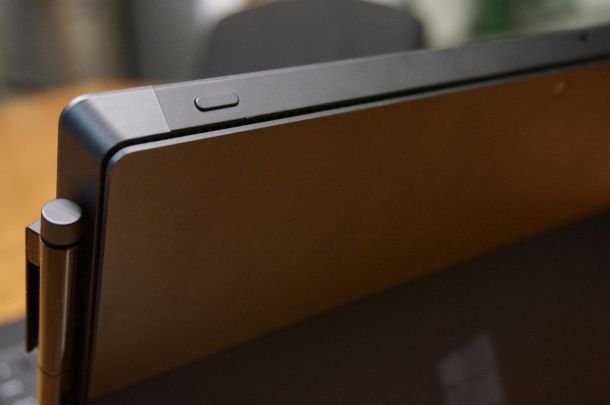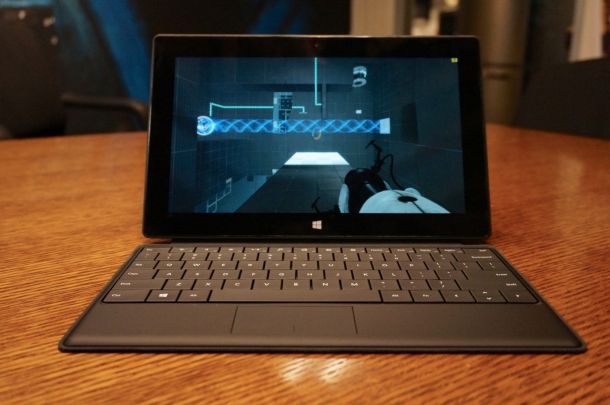Who is online?
In total there are 4 users online :: 0 Registered, 0 Hidden and 4 Guests None
Most users ever online was 77 on Wed Nov 20, 2024 3:31 pm
Top posting users this month
| No user |
Microsoft Surface Pro Hands-On
Page 1 of 1
 Microsoft Surface Pro Hands-On
Microsoft Surface Pro Hands-On
After releasing the stripped down, ARM processor-based Surface RT
last year, Microsoft's Intel-based variant of its tablet PC, the Surface
Pro, has arrived. Offering all the same luxuries of a Windows 8 PC but
in a compact, all-in-one tablet form factor, the Surface Pro lets
consumers install and operate both traditional third-party software and
tablet-optimized apps. The concept and value proposition is certainly
intriguing, especially given the limitations and performance issues plaguing its weaker sibling, so naturally I was excited to get my hands-on one for the first time earlier this week.

Surface Pro (Left) and Surface RT (Right)
What struck me first about the Surface Pro was how significantly
heavier and thicker it is than the Surface RT — roughly 43-percent
thicker and 33-percent heavier, to be exact. While it's still thinner
and lighter than the MacBook Air and most ultrabooks, it's on the
heftier side of the spectrum in the tablet form factor. But then again,
few other devices in the tablet category are capable of running a full
build of Windows.
Aside from the obvious size and weight differential, the Surface RT
and Surface Pro share a very similar build; using the same materials and
a familiar design. The major difference is the Surface Pro has a small
slit that extends around the perimeter of the casing that provides
ventilation for the more powerful, and subsequently temperature-raising
internals. The Surface Pro also trades the single USB 2.0 port for two
USB 3.0 ports and adds a miniDisplay port for video output.

Surface Pro (Bottom), Surface RT (Top)
But again, what's most unique about the Surface Pro is its guts. The
Surface Pro sports a dual-core 1.7GHz Intel Core i5 processor with
integrated Intel HD 4000 graphics, 4GB of RAM, and either 64GB or 128GB
of storage. This marks a significant boost over the RT, which is powered
by an NVIDIA Tegra 3, 2GB of RAM, and comes with 32GB or 64GB of
storage. What's more, the screen is notably better, going from 1368x768
on the Surface RT to 1920x1080 on the Surface Pro — a 40-percent
increase in pixel density.
The impact of the upgraded internals on performance and user
experience is impressive. Seemingly gone are the frequently long load
times, sluggish touchscreen responsiveness, and app freezes. While I
have noticed some odd moments of slowdown in my early testing, the
Surface Pro is overall pretty stable and speedy.

As previously mentioned, the Surface Pro offers a full, unhindered
build of Windows 8 and offers the full desktop experience found on a
traditional PC. As a result, the Surface Pro is capable of accessing a
wide range of PC titles through services like Steam and Origin. While
certainly not intended as a gaming device, the integrated graphics
processor allows the Surface Pro to run many games adeptly. While I've
only just started stress-testing the system, I've found it can handle
most Source Engine-based titles at max or high settings in native 1080p
resolution at framerates well above 40fps. Naturally, it struggles with
more taxing titles, like Saints Row: The Third or Dead Island, but I'll
be providing a greater sense of its range of performance in the coming
days.

There's also the looming question of battery life. Microsoft has
quoted the Surface Pro as having half the battery life of the RT, which
achieved roughly 8 hours per charge. But depending on usage, especially
when playing games, the Surface Pro could slip well below four hours of
usage.
Answers to those questions and more as I continue testing and publish
a complete review. Until then, stay tuned for more hands-on coverage,
and be sure to voice your thoughts and submit questions in the comments
below.
last year, Microsoft's Intel-based variant of its tablet PC, the Surface
Pro, has arrived. Offering all the same luxuries of a Windows 8 PC but
in a compact, all-in-one tablet form factor, the Surface Pro lets
consumers install and operate both traditional third-party software and
tablet-optimized apps. The concept and value proposition is certainly
intriguing, especially given the limitations and performance issues plaguing its weaker sibling, so naturally I was excited to get my hands-on one for the first time earlier this week.

Surface Pro (Left) and Surface RT (Right)
What struck me first about the Surface Pro was how significantly
heavier and thicker it is than the Surface RT — roughly 43-percent
thicker and 33-percent heavier, to be exact. While it's still thinner
and lighter than the MacBook Air and most ultrabooks, it's on the
heftier side of the spectrum in the tablet form factor. But then again,
few other devices in the tablet category are capable of running a full
build of Windows.
Aside from the obvious size and weight differential, the Surface RT
and Surface Pro share a very similar build; using the same materials and
a familiar design. The major difference is the Surface Pro has a small
slit that extends around the perimeter of the casing that provides
ventilation for the more powerful, and subsequently temperature-raising
internals. The Surface Pro also trades the single USB 2.0 port for two
USB 3.0 ports and adds a miniDisplay port for video output.

Surface Pro (Bottom), Surface RT (Top)
But again, what's most unique about the Surface Pro is its guts. The
Surface Pro sports a dual-core 1.7GHz Intel Core i5 processor with
integrated Intel HD 4000 graphics, 4GB of RAM, and either 64GB or 128GB
of storage. This marks a significant boost over the RT, which is powered
by an NVIDIA Tegra 3, 2GB of RAM, and comes with 32GB or 64GB of
storage. What's more, the screen is notably better, going from 1368x768
on the Surface RT to 1920x1080 on the Surface Pro — a 40-percent
increase in pixel density.
The impact of the upgraded internals on performance and user
experience is impressive. Seemingly gone are the frequently long load
times, sluggish touchscreen responsiveness, and app freezes. While I
have noticed some odd moments of slowdown in my early testing, the
Surface Pro is overall pretty stable and speedy.

As previously mentioned, the Surface Pro offers a full, unhindered
build of Windows 8 and offers the full desktop experience found on a
traditional PC. As a result, the Surface Pro is capable of accessing a
wide range of PC titles through services like Steam and Origin. While
certainly not intended as a gaming device, the integrated graphics
processor allows the Surface Pro to run many games adeptly. While I've
only just started stress-testing the system, I've found it can handle
most Source Engine-based titles at max or high settings in native 1080p
resolution at framerates well above 40fps. Naturally, it struggles with
more taxing titles, like Saints Row: The Third or Dead Island, but I'll
be providing a greater sense of its range of performance in the coming
days.

There's also the looming question of battery life. Microsoft has
quoted the Surface Pro as having half the battery life of the RT, which
achieved roughly 8 hours per charge. But depending on usage, especially
when playing games, the Surface Pro could slip well below four hours of
usage.
Answers to those questions and more as I continue testing and publish
a complete review. Until then, stay tuned for more hands-on coverage,
and be sure to voice your thoughts and submit questions in the comments
below.
 Similar topics
Similar topics» Report: Microsoft Phasing out Microsoft Points
» Halo 4 DLC Achievements Surface
» first Halo hands-on
» HANDS ON BLACK OPS II
» Xbox 360 Successor Rumors Surface: Christmas 2013 Release.
» Halo 4 DLC Achievements Surface
» first Halo hands-on
» HANDS ON BLACK OPS II
» Xbox 360 Successor Rumors Surface: Christmas 2013 Release.
Page 1 of 1
Permissions in this forum:
You cannot reply to topics in this forum









